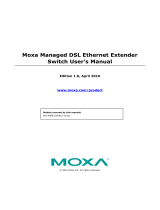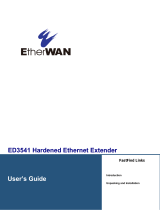Moxa Managed Ethernet Switch/Extender User manual
- Category
- Cellular network devices
- Type
- User manual
This manual is also suitable for

Moxa Managed DSL Ethernet Extender
User’s Manual
First Edition, March 2013
www.moxa.com/product
© 2013 Moxa Inc. All rights reserved.

Moxa Managed DSL Ethernet Extender
User’s Manual
The software described in this manual is furnished under a license agreement and may be used only in accordance with
the terms of that agreement.
Copyright Notice
© 2013 Moxa Inc. All rights reserved.
Trademarks
The MOXA logo is a registered trademark of Moxa Inc.
All other trademarks or registered marks in this manual belong to their respective manufacturers.
Disclaimer
Information in this document is subject to change without notice and does not represent a commitment on the part of
Moxa.
Moxa provides this document as is, without warranty of any kind, either expressed or implied, including, but not limited
to, its particular purpose. Moxa reserves the right to make improvements and/or changes to this manual, or to the
products and/or the programs described in this manual, at any time.
Information provided in this manual is intended to be accurate and reliable. However, Moxa assumes no responsibility for
its use, or for any infringements on the rights of third parties that may result from its use.
This product might include unintentional technical or typographical errors. Changes are periodically made to the
information herein to correct such errors, and these changes are incorporated into new editions of the publication.
Technical Support Contact Information
www.moxa.com/support
Moxa Americas
Toll
-free: 1-888-669-2872
Tel:
+1-714-528-6777
Fax:
+1-714-528-6778
Moxa China (Shanghai office)
Toll
-free: 800-820-5036
Tel:
+86-21-5258-9955
Fax:
+86-21-5258-5505
Moxa Europe
Tel:
+49-89-3 70 03 99-0
Fax: +49-89-3 70 03 99-99
Moxa Asia
-Pacific
Tel:
+886-2-8919-1230
Fax: +886-2-8919-1231
Moxa India
Tel:
+91-80-4172-9088
Fax:
+91-80-4132-1045

Table of Contents
1. About this Manual ............................................................................................................................. 1-1
2. Getting Started.................................................................................................................................. 2-1
Serial Console Configuration (115200, None, 8, 1, VT100) ....................................................................... 2-2
Configuration via Telnet Console ........................................................................................................... 2-4
Configuration via Web Browser ............................................................................................................. 2-6
Disabling Telnet and Browser Access ..................................................................................................... 2-7
3. Featured Functions ........................................................................................................................... 3-1
Product Overview ............................................................................................................................... 3-2
Wiring the Devices ...................................................................................................................... 3-2
Getting Started ........................................................................................................................... 3-2
4. Diagnostics, Management, and Performance ..................................................................................... 4-1
On-site Troubleshooting ...................................................................................................................... 4-2
Remote Management .......................................................................................................................... 4-3
Performance ...................................................................................................................................... 4-4
A. MIB Groups ....................................................................................................................................... A-1

1
1. About this Manual
Thank you for purchasing Moxa’s managed DSL Ethernet extender. Read this user’s manual to learn how to
connect your DSL Ethernet extender to Ethernet-enabled devices in industrial applications.
The following two chapters are covered in this user manual:
Getting Started
This chapter explains the initial installation process for the DSL Ethernet extender. There are three ways to
access configuration settings: serial console, Telnet console, and web console.
Featured Functions
This chapter explains how to access various configuration, monitoring, and administration functions. These
functions can be accessed via serial, Telnet, or web console. The web console is the most user-friendly way
to configure the DSL Ethernet extender. In this chapter, we will use the web console interface to introduce
the functions.

2
2. Getting Started
This chapter explains how to install a Moxa DSL Ethernet extender for the first time. There are three ways to
access the configuration settings: serial console, Telnet console, and web console. If you do not know the DSL
Ethernet extender’s IP address, you can open the serial console by connecting the DSL Ethernet extender to a
PC’s COM port with a short serial cable. You can open the Telnet or web console over an Ethernet LAN or over
the Internet.
The following topics are covered in this chapter:
Serial Console Configuration (115200, None, 8, 1, VT100)
Configuration via Telnet Console
Configuration via Web Browser
Disabling Telnet and Browser Access

Moxa Managed DSL Ethernet Extender Getting Started
2-2
Serial Console Configuration (115200, None, 8,
1, VT100)
NOTE
•
You cannot connect to the serial and Telnet console at the same time.
•
You can connect to the web console and another console (serial or Telnet) at the same time. However, we
strongly recommend that you do NOT do so. Following this advice will allow you to maintain better control
over the Moxa DSL Ethernet extender’s configuration.
NOTE
We recommend
using PComm Terminal Emulator when opening the serial console. This software can be
downloaded free of charge from the Moxa website.
Before running PComm Terminal Emulator, use an RJ45 to DB9-F (or RJ45 to DB25-F) cable to connect the
Moxa DSL Ethernet extender’s console port to your PC’s COM port (generally COM1 or COM2, depending on how
your system is set up).
After installing PComm Terminal Emulator, open the Moxa DSL Ethernet extender’s serial console as follows:
1. From the Windows desktop, click Start Programs PComm Lite 1.3 Terminal Emulator.
2. Select Open under the Port Manager menu to open a new connection.

Moxa Managed DSL Ethernet Extender Getting Started
2-3
3. The Property window should open. On the Communication Parameter tab for Ports, select the COM
port that is being used for the console connection. Set the other fields as follows: 115200 for Baud Rate,
8 for Data Bits, None for Parity, and 1 for Stop Bits.
4. On the Terminal tab, select VT100 for Terminal Type, and then click OK to continue.
5. In the terminal window, the Moxa DSL Ethernet extender will prompt you to select a terminal type. Enter 1
to select ansi/vt100 and then press Enter.

Moxa Managed DSL Ethernet Extender Getting Started
2-4
6. The serial console will prompt you to log in. Press Enter and select admin or user. Use the down arrow key
on your keyboard to select the Password field and enter a password if desired. This password will be
required to access any of the consoles (web, serial, Telnet). If you do not wish to create a password, leave
the Password field blank and press Enter.
7. The Main Menu of the Moxa DSL Ethernet extender’s serial console should appear. (In PComm Terminal
Emulator, you can adjust the font by selecting Font… from the Edit menu.)
8. Use the following keys on your keyboard to navigate through the Moxa DSL Ethernet extender’s serial
console:
Key Function
Up, down, right, left arrow keys,Tab Move the onscreen cursor
Enter Display and select options
Space Toggle options
Esc Previous menu
Configuration via Telnet Console
Opening the Moxa DSL Ethernet extender’s Telnet or web console over a network requires that the PC host and
the Moxa DSL Ethernet extender are on the same logical subnet. You may need to adjust your PC host’s IP
address and subnet mask. By default, the Moxa DSL Ethernet extender’s IP address is 192.168.127.253 and
the subnet mask is 255.255.255.0 (referred to as a Class B network). Your PC’s IP address must be set to
192.168.xxx.xxx if the subnet mask is 255.255.0.0, or to 192.168.127.xxx if the subnet mask is
255.255.255.0.
NOTE
To connect to the Moxa DSL Ethernet extender’s Telnet
or web console, your PC host and the Moxa DSL
Ethernet extender must be on the same logical subnet.
NOTE
When connecting to the Moxa DSL Ethernet extender’s Telnet or web console, first connect one of the Moxa DSL
Ethernet extender’s Ethernet ports to your Ethernet LAN, or directly to your PC’s Ethernet port. You may use
either a straight
-through or a cross-over Ethernet cable.

Moxa Managed DSL Ethernet Extender Getting Started
2-5
NOTE
The Moxa DSL Ethernet extender’s default IP address is 192.168.127.253.
After making sure that the Moxa DSL Ethernet extender is connected to the same LAN and logical subnet as
your PC, open the Moxa DSL Ethernet extender’s Telnet console as follows:
1. Click Start Run from the Windows Start menu and then Telnet to the Moxa DSL Ethernet extender’s IP
address from the Windows Run window. You may also issue the Telnet command from a DOS prompt.
2. In the terminal window, the Telnet console will prompt you to select a terminal type. Type 1 to choose
ansi/vt100, and then press Enter.
3. The Telnet console will prompt you to log in. Press Enter and then select admin or user. Use the down
arrow key on your keyboard to select the Password field and enter a password if desired. This password
will be required to access any of the consoles (web, serial, Telnet). If you do not wish to create a password,
leave the Password field blank and press Enter.
4. The Main Menu of the Moxa DSL Ethernet extender’s Telnet console should appear.
5. In the terminal window, select Preferences… from the Terminal menu on the menu bar.
6. The Terminal Preferences window should appear. Make sure that VT100 Arrows is checked.

Moxa Managed DSL Ethernet Extender Getting Started
2-6
7. Use the following keys on your keyboard to navigate through the Moxa DSL Ethernet extender’s Telnet
console:
Key Function
Up, down, right, left arrow keys, Tab Move the onscreen cursor
Enter Display and select options
Space Toggle options
Esc Previous menu
NOTE
The Telnet console looks and operates in precisely the same manner as the serial console.
Configuration via Web Browser
The Moxa DSL Ethernet extender’s web console is a convenient platform for modifying device configuration and
accessing the built-in monitoring and network administration functions. You can open the Moxa DSL Ethernet
extender’s web console using a standard web browser, such as Internet Explorer.
NOTE
To connect to the Moxa DSL Ethernet extender’s Telnet or web console, your PC host and the Moxa DSL
Ethernet extender must be on the same logical subnet.
NOTE
If the Moxa DSL Ethernet extender is configured for other VLAN settings, you must make sure that your PC host
is on the management VLAN.
NOTE
When connecting to the Moxa DSL Ethernet extender’s Telnet or web console, first connect one of the Moxa DSL
Ethernet extender’s Ethernet ports to your Ethernet LAN, or directly to your PC’s Ethernet port. You may use
either a straight
-through or a cross-over Ethernet cable.
NOTE
The Moxa DSL Ethernet extender’s default IP address is 192.168.127.253.
After making sure that the Moxa DSL Ethernet extender is connected to the same LAN and logical subnet as
your PC, open the Moxa DSL Ethernet extender’s web console as follows:
1. Connect your web browser to the Moxa DSL Ethernet extender’s IP address by entering it in the Address
or URL field.

Moxa Managed DSL Ethernet Extender Getting Started
2-7
2. The Moxa DSL Ethernet extender’s web console will open, and you will be prompted to log in. Select the
login account (admin or user) and enter the Password. This password will be required to access any of the
consoles (web, serial, Telnet). If you do not wish to create a password, leave the Password field blank and
press Enter.
NOTE
By default, no password is assigned to the Moxa DSL Ethernet extender’s web, serial, and Telnet consoles.
3. After logging in, you may need to wait a few moments for the web console to appear. Use the folders in the
left navigation panel to navigate between different pages of configuration options.
Disabling Telnet and Browser Access
If you are connecting the Moxa DSL Ethernet extender to a public network but do not intend to manage it over
the network, we suggest disabling both the Telnet and web consoles. This is done from the serial console by
navigating to System Identification under Basic Settings. Disable or enable the Telnet Console and Web
Configuration as shown below:

3
3. Featured Functions
In this chapter, we explain how to access the Moxa DSL Ethernet extender’s various configuration, monitoring,
and administration functions. These functions can be accessed by serial, Telnet, or web console. The serial
console can be used if you do not know the Moxa DSL Ethernet extender’s IP address and requires that you
connect the Moxa DSL Ethernet extender to a PC COM port. The Telnet and web consoles can be opened over
an Ethernet LAN or the Internet.
The web console is the most user-friendly interface for configuring a Moxa DSL Ethernet extender. In this
chapter, we use the web console interface to introduce the functions. There are only a few differences between
the web console, serial console, and Telnet console.
The following topics are covered in this chapter:
Product Overview
Wiring the Devices
Getting Started

Moxa Managed DSL Ethernet Extender Featured Functions
3-2
Product Overview
MOXA’s IEX series are entry-level managed DSL Ethernet extenders that allow you to extend the point-to-point
Ethernet connections over DSL technology in a cost-effective way. With the IEX series, networks can be set up
without additional fiber upgrades or reconstruction by leveraging existing copper wiring resources. Compliant
with G.SHDSL.bis and VDSL2 standards, the IEX-402-SHDSL series supports data rates of up to 15.3 Mbps
across distances of up to 8 km. The IEX-402-VDSL2 series fulfill high bandwidth requirements of up to 100
Mbps across distances of up to 3 km (transmission data rate depends on cable quality, environmental noise,
and connection distance).
For simple installation, the following configuration steps allow you to effectively reduce deployment time,
simplify maintenance, and enhance manageability.
Wiring the Devices
MOXA’s IEX series have two ports. The upper port is a 10/100BaseT(x) port for connecting to an
Ethernet-enabled device such as a switch or a PLC. The lower port is designed to connect both DSL extenders
through a twisted-pair copper wire.
Getting Started
Step 1: DIP Switch Settings
Both extenders need to have the same DIP switch settings (except when manually configuring CO/CPE
designations).

Moxa Managed DSL Ethernet Extender Featured Functions
3-3
1st DIP switch: CO/CPE Assignment
The DSL Ethernet extenders need to work in pairs with one unit designated as a CO (central office) device and
the other as a CPE (customer premise equipment) device. In addition to manual configuration by selecting the
DIP switch settings (CO/CPE) on both devices, the IEX series can also perform automatic CO/CPE designation
when both extenders are set as CO devices (all IEX series extenders are set as CO by default). The system will
auto-negotiate to assign CPE to one of the devices in each connected pair and will decide the maximum
transmission data rate based on line conditions.
NOTE
•
Time from device boot-up to connection-ready status: 70 seconds to 6 minutes, depending on line
conditions.
•
The DSL port is designed to be used on private communication lines for point-to-point connections only
and
is not able to be connected to the Public Switched Telephone Networks (PSTN).
NOTE
•
For the IEX-402-SHDSL series, the Auto CO/CPE negotiation is only available under STD mode.
•
The system-ready time with auto CO/CPE negotiation takes approximately 20 seconds to 3 minute
s longer
(depending on line conditions) than when manually pre-defining
the devices (one as a CO and the other as
a CPE device) using the with DIP switch settings.
2nd DIP Switch: SNR/Speed Display Information
The second DIP switch is used to select whether the transmission speed or the SNR (signal-to-noise ratio) is
displayed on the DSL Speed/SNR LED indicator. More signal bars means higher DSL speed or SNR.
IEX
-402-SHDSL Series
Turbo Speed (K bits) STD Speed (K bits) SNR (dB)
5 10297 – 15304 4609 – 5760 18 – 30
4 5697 – 10296 3073 – 4608 14 – 17
3 3457 – 5696 2049 – 3072 10 – 13
2 1025 – 3456 769 – 2048 6 – 9
1
192 – 1024
192 – 768
3 – 5
IEX
-402-VDSL2 Series
Asymmetric
TX Speed (Kbps)
Symmetric
TX Speed (Kbps)
SNR (dB)
5 80001 - 100000 60001 - 100000 21-30
4 55001 - 80000 30001 - 60000 13-20
3 20001 - 55000 15001 - 30000 6-12
2 5001 - 20000 4001 - 15000 5
1 256 - 5000 256 - 4000 3-4

Moxa Managed DSL Ethernet Extender Featured Functions
3-4
3rd DIP Switch: Annex A/Annex B Assignment (IEX-402-SHDSL Series
Only)
Generally, DSL supports different band plans and modulations for transmission over POTS or ISDN. For
point-to-point applications, the Annex A/Annex B selection refers to the cable type between DSL ports of both
devices. If the cable is US-Type/0.5mm, please configure as ANNEX A. Otherwise, please set as default ANNEX
B.
NOTE
The DSL link
can still to be established if the cable type and DIP switch settings do not match.
However, there
will be a slight p
erformance difference of less than 100kbps at the same transmission distance.
4th DIP Switch:
STD/Turbo Speed Selection(IEX-402-SHDSL Series Only)
The IEX-402-SHDSL series supports 2 transmission speed settings; STD (standard) mode and TURBO mode.
STD mode supports speeds from 192 kbps to 5696 kbps and the maximum speed supported by TURBO mode
is 15.3 Mbps. The shorter the connection distance between DSL ports, the faster the transmission speed (not
taking environmental noises into consideration). If Turbo mode is enabled, the unit will step through the
different rates of speed until the best bit-rate is decided based on the line conditions. During the speed training
process, the DSL connection will constantly disconnect and connect again. It takes less than 6 minutes to
complete the training process.
NOTE
•
TURBO mode supports higher transmission speeds when the DSL connection distance is less than 1.5
kilometers.
•
Auto CO/CPE assignment is not valid when TURBO mode is enabled. Please manually assign one as
a CO
device and the other as a CPE device.
•
Under Turbo mode, when DSL disconnects during a stable connection because of external factors (e.g.,
reduced SNR, cable unplugged and plugged in again), the system will try to re-
establish the link and keep
the connection speed less or equal to 5696 kbps in order to provide a stable transmission quality.
STD/INP Mode Selection (IEX-402-VDSL2 Series Only)
The IEX-402-VDSL2 supports two transmission modes; STD (standard) mode and INP (impulse noise
protection) mode. STD mode means that data is transmitted directly between two connected points with 2 ms
latency. INP mode is used for applications which can encounter frequent man-made or natural electromagnetic
interference, e.g. communication equipment, electrical appliances, lightening discharges, etc. When INP mode
is enabled, DSL communication is protected from impulse noise with a duration of less than 500 μs and has a
maximum end-to-end transmission latency of 8 ms.
NOTE
For
reliable DSL connections, the throughput of INP mode is 3 Mbps slower than STD mode.
Step2: Advanced Settings
The Advanced Settings section includes the most common settings required by administrators to maintain
and control a Moxa DSL Ethernet extender.

Moxa Managed DSL Ethernet Extender Featured Functions
3-5
System Identification
System Identification items are displayed at the top of the web console and will be included in alarm emails.
You can configure the System Identification items to make it easier to identify different DSL Ethernet extenders
that are connected to your network.
DSL Ethernet Extender Name
Setting Description Factory Default
Max. 30 characters This option is useful for differentiating between the roles or
applications of different units. Example: Factory DSL Ethernet
extender 1.
Industrial Ethernet
DSL Ethernet
extender [Serial no.
of this DSL DSL
Ethernet extender]
DSL Ethernet Extender Location
Setting Description Factory Default
Max. 80 characters
This option is useful for differentiating between the locations of
different units. Example: production line 1.
DSL Ethernet
extender Location
DSL Ethernet Extender Description
Setting Description Factory Default
Max. 30 characters This option is useful for recording a more detailed description of
the unit.
MOXA [Model name
of this DSL DSL
Ethernet extender]
Maintainer Contact Info
Setting Description Factory Default
Max. 30 characters This option is useful for providing information about who is
responsible for maintaining this unit and how to contact this
person.
None

Moxa Managed DSL Ethernet Extender Featured Functions
3-6
Web Auto-logout (S)
Setting Description Factory Default
60 to 86400 (seconds) Disable or extend the auto-logout time for the web
management console.
0 (disabled)
Age Time (S)
Setting Description Factory Default
15 to 3825 (seconds) The length of time that a MAC address entry can remain in
the
Moxa DSL Ethernet extender. When an entry reaches its aging
time, it “ages out” and is purged from the DSL Ethernet
extender, effectively cancelling frame forwarding to that
specific port.
300
CPU Loading
Setting Description Factory Default
Read-only T
he CPU usage volume in the past 5 seconds, 30 seconds, and
5 minutes
None
Free Memory
Setting Description Factory Default
Read-only The immediately free memory of the DSL Ethernet extender None
Password
The Moxa DSL Ethernet extender provides two levels of configuration access. The admin account has
read/write access of all configuration parameters, and the user account has read access only. A user account
can view the configuration, but will not be able to make modifications.
ATTENTION
By default, a password is not assigned to the Moxa DSL Ethernet extender’s web, Telnet, and serial consoles.
If a password is assigned, you will be required to enter the password when you
open the seri
al console, Telnet
console, or w
eb console.
Account
Setting Description Factory Default
Admin This account can modify the Moxa DSL Ethernet extender’s
configuration.
admin
User This account can only view the Moxa DSL Ethernet extender’s
configurations.

Moxa Managed DSL Ethernet Extender Featured Functions
3-7
Password
Setting Description Factory Default
Old password
(max. 16 characters)
Enter the current password None
New password
(Max. 16 characters)
Enter the desired new password. Leave it blank if you want to
remove the password.
None
Retype password
(Max. 16 characters)
Enter the desired new password again. Leave it blank if you
want to remove the password.
None
Accessible IP List
The Moxa DSL Ethernet extender uses an IP address-based filtering method to control access.
You may add or remove IP addresses to limit access to the Moxa DSL Ethernet extender. When the accessible
IP list is enabled, only addresses on the list will be allowed access to the Moxa DSL Ethernet extender. Each IP
address and netmask entry can be tailored for different situations:
• Grant access to one host with a specific IP address
For example, enter the IP address 192.168.1.1 with netmask 255.255.255.255 to allow access from
192.168.1.1 only.
• Grant access to any host on a specific subnetwork
For example, enter the IP address 192.168.1.0 with netmask 255.255.255.0 to allow access from all IPs on
the subnet defined by this IP address/subnet mask combination.
• Grant access to all hosts
Make sure the accessible IP list is not enabled. Remove the checkmark from Enable the accessible IP
list.
The following table shows additional configuration examples:
Hosts That Need Access
Input Format
Any host Disable
192.168.1.120 192.168.1.120 / 255.255.255.255
192.168.1.1 to 192.168.1.254 192.168.1.0 / 255.255.255.0
192.168.0.1 to 192.168.255.254 192.168.0.0 / 255.255.0.0
192.168.1.1 to 192.168.1.126 192.168.1.0 / 255.255.255.128
192.168.1.129 to 192.168.1.254 192.168.1.128 / 255.255.255.128

Moxa Managed DSL Ethernet Extender Featured Functions
3-8
Port Settings
Ethernet Port Settings
Port settings include port transmission speed, flow control, and port type (MDI or MDIX).
Description
Setting Description Factory Default
Media type Displays the media type for each module’s port N/A
Name
Setting Description Factory Default
Max. 63 characters Specifies an alias for the port to help administrators
differentiate between different ports. Example: PLC 1
None
Speed
Setting Description Factory Default
Auto
Allows the port to use the IEEE 802.3u protocol to negotiate
with connected devices. The port and connected devices will
determine the best speed for that connection.
Auto
1G-Full
Choose one of these fixed speed options if the connected
Ethernet device has trouble auto-negotiating for line speed.
100M-Full
100M-Half
10M-Full
10M-Half
FDX Flow Ctrl
This setting enables or disables flow control for the port when the port Speed is set to Auto. The final result will
be determined by the Auto process between the Moxa DSL Ethernet extender and connected devices.
Setting Description Factory Default
Enable Enables flow control for this port when the port’s Speed is set to
Auto.
Disabled
Disable
Disables flow control for this port when the port’s Speed is set
to Auto.
MDI/MDIX
Setting Description Factory Default
Auto Allows the port to auto-detect the port type of the connected
Ethernet device and change the port type accordingly.
Auto
MDI Choose MDI or MDIX if the connected Ethernet device has
trouble auto-negotiating for port type.
MDIX

Moxa Managed DSL Ethernet Extender Featured Functions
3-9
DSL Port Settings
DSL port settings provide the interface to configure the port transmission speed
IEX-402-SHDSL Series
Description
Setting Description Factory Default
Standard Display the standard of DSL port G.SHDSL.bis
Name
Setting Description Factory Default
Max. 63 characters Specifies an alias for the port to help administrators
differentiate between different devices. Example: Site_A
None
Mode (SET/ACT)
Setting Description Factory Default
Device type SET: The value same as CO/CPE DIP switch configuration
ACT: The value after connected pairs negotiation
CO/CO or CPE after
negotiation
Turbo
The IEX-402-SHDSL series support two communication modes; Standard (STD) and Turbo. The difference is
the transmission data rate, highest up to 5.7Mbps and 15.3Mbps for standard and turbo mode respectively. The
higher the transmission data rate, the shorter the connection distance. In other words, lower data rates can
extend the transmission over a longer distance.
In standard mode, the connection speed is decided once the connection is established between the CO and the
CPE based on line conditions, including distance, SNR (signal-to-noise ratio) and cable quality. However, the
transmission speed of Turbo mode will be auto detected from 5696 Kbps to 15.3 Mbps gradually. It should take
less than 7 minutes to complete the training process.
Setting Description Factory Default
Turbo mode status Indicates whether turbo mode is enabled or not based on DIP
switch configuration
Disabled
Speed
Transmission speed can only be configured while Turbo mode is disabled. It shows the list of configurable
transmission speeds.
Setting Description Factory Default
Transmission speed Auto: Allows the DSL ports to
negotiate the best transmission
speed based on line conditions.
Fixed speed: Manually assigning one of these fixed speed
options:
192K, 384K, 512K, 768K, 1024K, 1280K, 2048K, 2304K,
2688K, 3072K, 3456K, 4224K, 4608K, 4992K, 5376K, 5696K
Auto
NOTE
Device will try to attain the set speed. If line
condition degrades
(reducing SNR) but the device is able to keep
the link, the DSL SNR/SPEED LED is the indicator to notify user of the reduced SNR. However, if the line
condition is too poor to maintain the link, the connection will be very unstable or di
sabled to re-establish
connection, MOXA recommends manually assigning a lower transmission speed or to auto mode until the link
is able to be established.
Page is loading ...
Page is loading ...
Page is loading ...
Page is loading ...
Page is loading ...
Page is loading ...
Page is loading ...
Page is loading ...
Page is loading ...
Page is loading ...
Page is loading ...
Page is loading ...
Page is loading ...
Page is loading ...
Page is loading ...
Page is loading ...
Page is loading ...
Page is loading ...
Page is loading ...
Page is loading ...
Page is loading ...
Page is loading ...
Page is loading ...
-
 1
1
-
 2
2
-
 3
3
-
 4
4
-
 5
5
-
 6
6
-
 7
7
-
 8
8
-
 9
9
-
 10
10
-
 11
11
-
 12
12
-
 13
13
-
 14
14
-
 15
15
-
 16
16
-
 17
17
-
 18
18
-
 19
19
-
 20
20
-
 21
21
-
 22
22
-
 23
23
-
 24
24
-
 25
25
-
 26
26
-
 27
27
-
 28
28
-
 29
29
-
 30
30
-
 31
31
-
 32
32
-
 33
33
-
 34
34
-
 35
35
-
 36
36
-
 37
37
-
 38
38
-
 39
39
-
 40
40
-
 41
41
-
 42
42
-
 43
43
Moxa Managed Ethernet Switch/Extender User manual
- Category
- Cellular network devices
- Type
- User manual
- This manual is also suitable for
Ask a question and I''ll find the answer in the document
Finding information in a document is now easier with AI
Related papers
-
 Moxa Technologies IEX-408E-2VDSL2 series User manual
Moxa Technologies IEX-408E-2VDSL2 series User manual
-
Moxa TN-5500A Series User manual
-
Moxa PT-7728 Series User manual
-
Moxa MDS-G4028-L3 Series User manual
-
Moxa RKS-G4028 Series User manual
-
Moxa MDS-G4012 Series User manual
-
Moxa ICS-G7826A Series User manual
-
Moxa MXview Series Quick setup guide
-
 Moxa Technologies SDS-3008 Series User manual
Moxa Technologies SDS-3008 Series User manual
-
Moxa MXview Series User manual
Other documents
-
Valueline TEL-C4030F Datasheet
-
 Moxa Technologies PT-G7828 User manual
Moxa Technologies PT-G7828 User manual
-
 EtherWAN ED3541 Series User manual
EtherWAN ED3541 Series User manual
-
Black Box MT196A-E1 Owner's manual
-
Sencore Impulse 300D Quick start guide
-
Zhone SNE2000G-P-US Datasheet
-
 Moxa Technologies ToughNet TN-5518 Series User manual
Moxa Technologies ToughNet TN-5518 Series User manual
-
 Moxa Technologies EDS-408A User manual
Moxa Technologies EDS-408A User manual
-
CTC Union SHDTU03b-ET100BS User manual
-
 Moxa Technologies EDS-405A User manual
Moxa Technologies EDS-405A User manual

















































